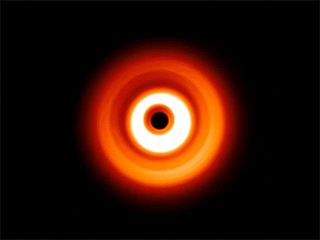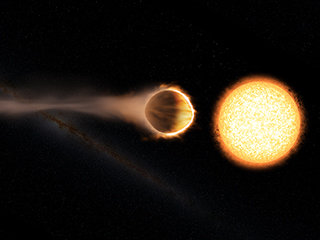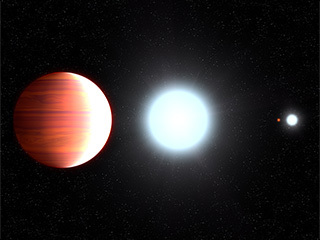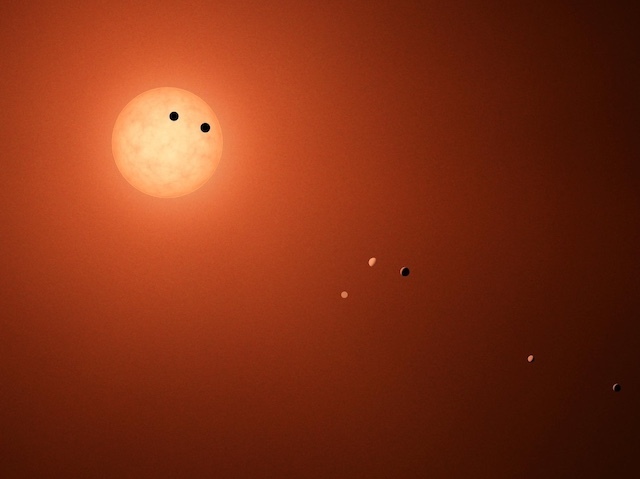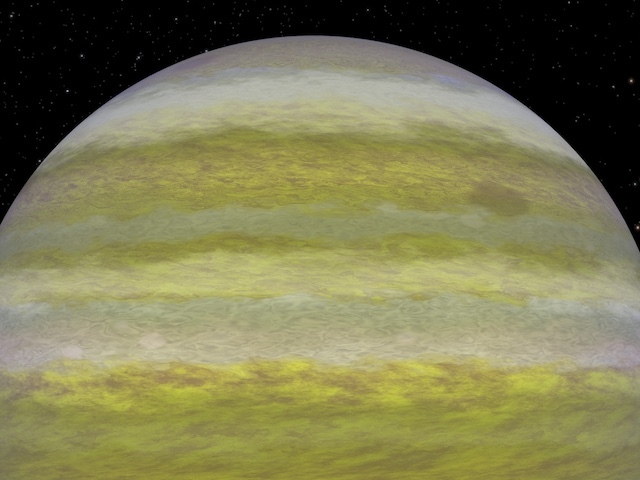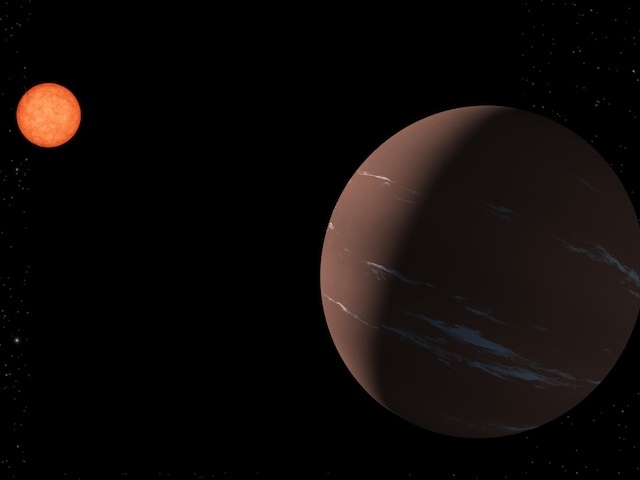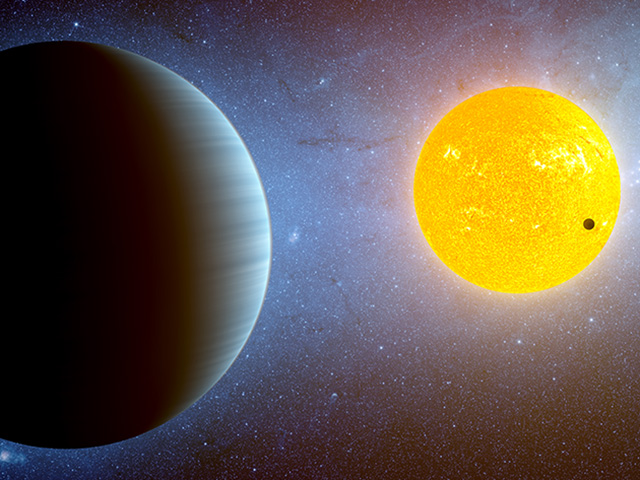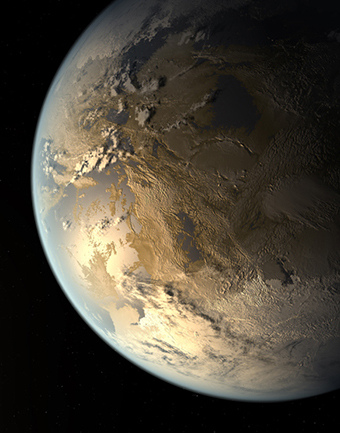News | May 2, 2018
Hubble detects helium in the atmosphere of an exoplanet for the first time

The exoplanet WASP-107b is a gas giant, orbiting a highly active K-type main sequence star. The star is about 200 light-years from Earth. Using spectroscopy, scientists were able to find helium in the escaping atmosphere of the planet — the first detection of this element in the atmosphere of an exoplanet. Credit: ESA/Hubble, NASA, M. Kornmesser
Astronomers using NASA's Hubble Space Telescope have detected helium in the atmosphere of the exoplanet WASP-107b. This is the first time this element has been detected in the atmosphere of a planet outside the solar system. The discovery demonstrates the ability to use infrared spectra to study exoplanet extended atmospheres.
The international team of astronomers, led by Jessica Spake, a PhD student at the University of Exeter in the UK, used Hubble's Wide Field Camera 3 to discover helium in the atmosphere of the exoplanet WASP-107b. This is the first detection of its kind.
Spake explained the importance of the discovery: "Helium is the second-most common element in the universe after hydrogen. It is also one of the main constituents of the planets Jupiter and Saturn in our solar system. However, up until now helium had not been detected on exoplanets — despite searches for it."
The team made the detection by analyzing the infrared spectrum of the atmosphere of WASP-107b. Previous detections of extended exoplanet atmospheres have been made by studying the spectrum at ultraviolet and optical wavelengths; this detection therefore demonstrates that exoplanet atmospheres can also be studied at longer wavelengths.
The measurement of an exoplanet's atmosphere is performed when the planet passes in front of its host star. A tiny portion of the star's light passes through the exoplanet's atmosphere, leaving detectable fingerprints in the spectrum of the star. The larger the amount of an element present in the atmosphere, the easier the detection becomes.
"The strong signal from helium we measured demonstrates a new technique to study upper layers of exoplanet atmospheres in a wider range of planets," said Spake. "Current methods, which use ultraviolet light, are limited to the closest exoplanets. We know there is helium in the Earth's upper atmosphere and this new technique may help us to detect atmospheres around Earth-sized exoplanets — which is very difficult with current technology."
WASP-107b is one of the lowest density planets known: While the planet is about the same size as Jupiter, it has only 12 percent of Jupiter's mass. The exoplanet is about 200 light-years from Earth and takes less than six days to orbit its host star.
The amount of helium detected in the atmosphere of WASP-107b is so large that its upper atmosphere must extend tens of thousands of miles out into space. This also makes it the first time that an extended atmosphere has been discovered at infrared wavelengths.
Since its atmosphere is so extended, the planet is losing a significant amount of its atmospheric gases into space — between about 0.1 percent to 4 percent of its atmosphere's total mass every billion years.
Stellar radiation has a significant effect on the rate at which a planet's atmosphere escapes. The star WASP-107 is highly active, supporting the atmospheric loss. As the atmosphere absorbs radiation it heats up, so the gas rapidly expands and escapes more quickly into space.
As far back as the year 2000, it was predicted that helium would be one of the most readily-detectable gases on giant exoplanets, but until now, searches were unsuccessful.
David Sing, co-author of the study also from the University of Exeter, concluded: "Our new method, along with future telescopes such as NASA's James Webb Space Telescope, will allow us to analyze atmospheres of exoplanets in far greater detail than ever before."
The team's study appears on May 2, 2018, in the online issue of science journal Nature.
The international team of astronomers in this study consists of J. Spake (University of Exeter, Exeter, UK), D. Sing (University of Exeter, Exeter, UK; Johns Hopkins University, Baltimore, Maryland), T. Evans (University of Exeter, UK), A. Oklopčić (Harvard-Smithsonian Center for Astrophysics, Cambridge, Massachusetts), V. Bourrier (University Geneva Observatory, Sauverny, Switzerland), L. Kreidberg (Harvard Society of Fellows and Harvard-Smithsonian Center for Astrophysics, Cambridge, Massachusetts), B. Rackham (University of Arizona, Tucson, Arizona), J. Irwin (Harvard-Smithsonian Center for Astrophysics, Cambridge, Massachusetts), D. Ehrenreich and A. Wyttenbach (University of Geneva Observatory, Sauverny, Switzerland), H. Wakeford (Space Telescope Science Institute, Baltimore, Maryland), Y. Zhou (University of Arizona, Tucson, Arizona), K. Chubb (University College London, London, UK), N. Nikolov and J. Goyal (University of Exeter, Exeter, UK), G. Henry and M. Williamson (Tennessee State University, Nashville, Tennessee), S. Blumenthal (Space Telescope Science Institute, Baltimore, Maryland), D. Anderson and C. Hellier (Keele University, Staffordshire, UK), D. Charbonneau (Harvard-Smithsonian Center for Astrophysics, Cambridge, Massachusetts), S. Udry (University of Geneva Observatory, Sauverny, Switzerland), and N. Madhusudhan (University of Cambridge, Cambridge, UK).
The Hubble Space Telescope is a project of international cooperation between NASA and ESA (European Space Agency). NASA's Goddard Space Flight Center in Greenbelt, Maryland, manages the telescope. The Space Telescope Science Institute (STScI) in Baltimore, Maryland, conducts Hubble science operations. STScI is operated for NASA by the Association of Universities for Research in Astronomy in Washington, D.C.

